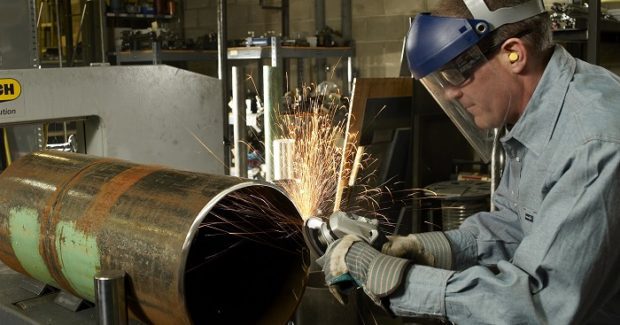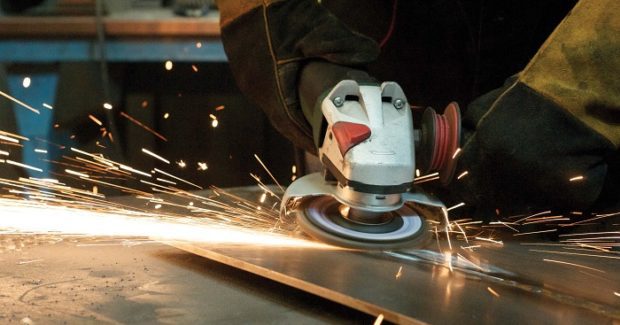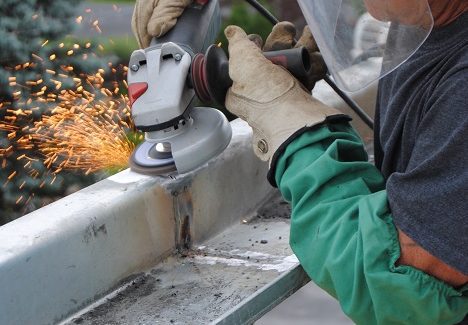The Right Flap Disc Can Save Time and Money
Selecting the right disposable flap disc to use for a specific grinding, blending or finishing job also minimizes the risk of removing too much material and ensures the best possible finish. To maximize flap disc effectiveness and longevity, here are several key factors to consider for choosing the right tool for the job.
Posted: April 10, 2018
Choosing the right tool for metal grinding or finishing applications can save time and money. The best choice can also minimize the risk of removing too much material and ensure the best possible finish. Flap discs, in particular, provide delicate blending and finishing work, while still offering reliable grinding action. These features make them a versatile and efficient choice for many applications, including those involving thinner materials. The same grain types found in bonded abrasive cutting, grinding, and combination wheels are also used in flap discs, but the layered flap construction of a flap disc provides a softer, more forgiving feel. This makes flap discs ideal for grinding and finishing without the need to change to a different product or disc. To choose the right flap disc for the job, and to maximize product effectiveness and longevity, there are several key questions to consider:
- What material is being worked?
- What are the surface finish requirements and desired aesthetics of the finished piece?
- Are there time, productivity and efficiency requirements for the job?
- What are the labor and consumable costs involved?
FLAP DISC BASICS
Flap discs utilize coated abrasive material that adhere grains to a backing cloth. The cloth, often a cotton, polyester or blended material, is then cut into smaller flaps and layered to form the flap disc. As the grains deplete and lose their ability to cut, the flaps wear away, exposing fresh, sharp grains below. With proper use, flap discs can be used until the cloth is nearly worn down to the back plate. Flap discs are designed for use on right-angle grinders at angles from 5 deg to 35 deg. Type 27 flap discs have a flat profile and work well for finishing and applications that require lower grinding angles, such as 5 deg to 15 deg. Type 29 flap discs have a slight angle and are suited for more aggressive, higher-angle grinding. Hard grinding discs may be a better choice when the job calls for more aggressive action or grinding on rougher surfaces, since a flap disc’s cloth can catch or tear in these highly aggressive grinding applications.
https://youtu.be/0mh1_3mYbhk
GRAIN OPTIONS AND DISC SIZES
To choose the proper grain for the job, consider the requirements of the finished weld. Remember, the lower the number, the more coarse and aggressive the grit. Higher grit sizes are finer and provide better finish, but are less aggressive. Choose the highest grit possible that gets the job done to ensure the best possible finish. Flap discs are also available in standard-density and high-density options. A high-density disc has more cloth and is thicker, softer and longer lasting. High-density flap discs are a great option for grinding on curved or irregular surfaces. Disc size options range from 2 in to 7 in, and 2 in and 3 in flap discs can often replace a blending disc and provide up to 15 times the use. This can reduce the number of product changeovers, increasing productivity and significantly lowering the overall cost of use.
CHOOSING THE ABRASIVE MATERIAL
Disc performance is tied largely to the type of abrasive material used and the grit size of that material. The three grains primarily used are aluminum oxide, zirconia alumina and ceramic alumina. The goal is to find the flap disc that accomplishes the requirements of the application within the desired timeframe and budget. Aluminum oxide provides a consistent, low-cost product option, but zirconia alumina flap discs often offer the most versatility for the lowest cost benefit. For this reason, zirconia alumina flap discs are likely the most common flap disc used today. Not all zirconia alumina flap discs are created equal. Some lower-cost options are a blend of zirconia alumina and aluminum oxide grains. Other high performance options are 100 percent zirconia alumina grains. These discs maintain their cut-rate longer and don’t break down as quickly. Standard and high performance products are slightly more expensive upfront than aluminum oxide flap discs, but they offer greater heat resistance, toughness and durability.
Note that high performance flap discs are more expensive, but can provide a significantly lower overall cost of use by minimizing changeovers, reducing downtime, and increasing productivity. A third abrasive option is ceramic alumina, which is the most expensive, but also the longest lasting and most heat resistant. These flap discs have grains that are designed to fracture to create new, sharp edges. Ceramic flap discs maintain their sharpness and cut rate for a longer period of time. While ceramic flap discs are more expensive upfront, they often provide a lower overall cost of use when other factors are considered. They are the best choice for grinding harder materials like stainless, Inconel, titanium, armored and tool steels.
PROPER TECHNIQUE IS KEY
Proper technique helps maximize disc effectiveness and longevity. Putting too much pressure on a flap disc can result in premature wear or lead to gouging, undercutting, or heat buildup and discoloration. If there is a need to push harder to get a disc to perform, a coarser grit or different disc may be required. Applying too much pressure can damage the workpiece and can present health and safety concerns. Allow the disc to do the work to minimize the risk of stress-related injuries. When using premium cutting grains like ceramic alumina, it is important to use a tool that is powerful enough to maintain its rotational speed. An under-powered grinder can “bog down” under excessive pressure, which reduces the grain’s ability to fracture and self-sharpen.
Flap discs are designed so that the full width of the flap is used for optimum performance When grinding at too steep of an angle, the operator and the disc are working much harder, because they are not using the full width of the cloth. This can also reduce product life because it puts increased stress on the flap. When the edge of the flap wears prematurely, an operator will often discard the disc, throwing away much of the disc’s abrasive material and value. This is most common for users grinding at higher angles, while using Type 27 (flat) discs. Many times, simply switching to a Type 29 (conical) disc allows the full width of the flap to be used during the grinding operation, maximizing efficiency and reducing disc use. It’s especially important when finishing thin material to avoid removing too much metal, which can create a weak point. Selecting the least aggressive disc that will do the job, especially when tighter tolerances are required, helps prevent this.
If there is concern of removing too much material too quickly, or a specific finish requirement, it is best to start with a higher grit – 60 or 80 – and move down as necessary if additional aggression is required. Flap discs are designed to be used to the point where you can see glue through the flap. When properly used, a disc will continue to cut until the glue is visible. Following this tip can save significant product costs annually. While flap discs are disposable tools, steps can be taken to lengthen their life and usability. It is important to remember that there are several options and configurations that are manufactured to improve productivity, reduce downtime and provide greater cost savings. Consult your local distributor representative or manufacturer for recommendations specific to your needs.







